PERFECT SQUAT EXERCISES: BARBELL HACK SQUAT AND LUNGES
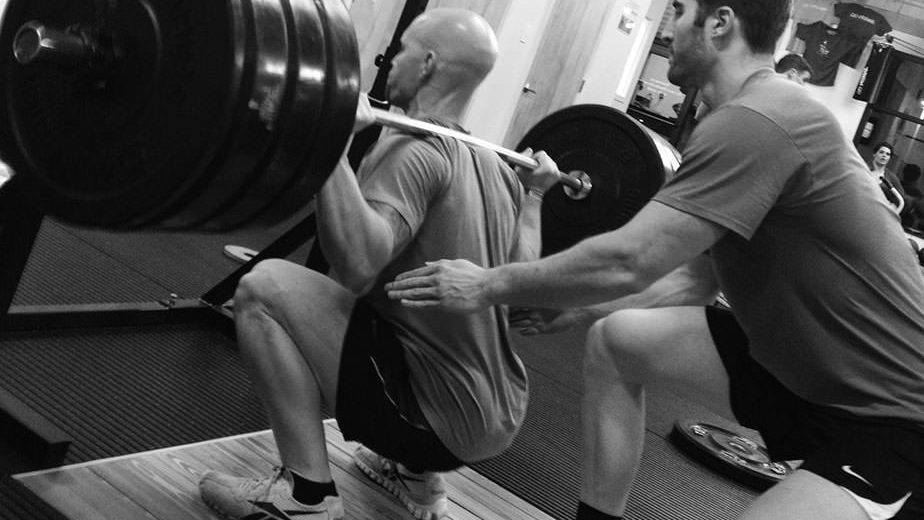
Squats have been the all-time choice for a perfect workout. But what is a perfect squat? How do you achieve a perfect squat? By adding some spice into it! Use several equipment and try different variations to make it more challenging and get twice the results from it. What exactly do I mean? Barbell Hack Squat and Lunges. These killer exercises will surely be your key to tighter glutes and toned leg muscles. They will be the solution to achieving those toned legs and thighs and tighter butt. Before we get further into this, first, let us take a detour to understand the nature of Squats.
What is a Squat, you say?
A Squat, as universally defined in any dictionary, is a position in which one’s knees are bent and one’s heels are close to or touching one’s buttocks or the back of one’s thighs. But, in the world of fitness and exercise, the Squat is a strikingly-aggressive and overwhelmingly-powerful lower body compound exercise that ultimately targets numerous muscles, particularly in the lower body. It primarily targets the thighs, hips, buttocks and hamstrings. In addition, it also strengthens the legs and develops core stability.
Trivia: Together with dead lifts and bench presses , the Squat is part of the three lifts in the sport of Powerlifting.
There are several variations of the squat. There are the basic squats and the squats that utilize equipment, such as the barbell, to intensify the difficulty and increase the effectiveness of the workout.
Why Should You Do a Squat?
The Squat is the perfect boost to overall fitness. This one exercise should never be absent in your daily routine. Aside from being relatively simple, it can be done by anyone and anywhere.
5 Benefits of Squats
- Tone your entire body. The squat is considered to be a compound exercise which engages numerous of muscles upon doing it. A few of the focus of the squats are the legs, buttocks and abs. But entirely, when doing a squat, your whole body participates, thus, the higher chances of muscle building and toning.
- Help with Waste Removal. As you do your regular squats, your body pumps bodily fluids which aids in the removal of wastes and toxins found inside your body. Therefore, the more you do your squats, the regular your bowel movement will become.
- Retain Stability and Balance. It is but a common fact that as we age, our muscles deteriorate and weaken due to lack of physical exercise, commonly; the squat is just the perfect remedy to maintain one’s mobility because it strengthens your leg muscles and improves body coordination and balance. It also prevents you from getting leg injuries easily.
- An Effective Fat-burner. Since squats let your whole body move, as a result, it will also burn more calories. An efficient way to burn those fats is to gain muscles and what better way to gain those muscles than to do a body-to-toe exercise.
- Improves Functionality. The Squat is basically the best functional exercise there is. It is a preparation of the body to perform excellently in real-life situations or activities. Not only you are great in lifting weights inside the gym, but you are also coordinated enough to catch-up with life.
How to do a Proper Squat?
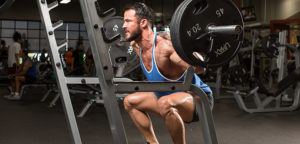
Before you deal with the intense Barbell Hack Squat and Lunges, you need, of course, to know how to do a proper basic squat. Here are directions and some tips to remember for you to perform a squat perfectly.
Here is how to do it:
- Stand in a hip-width stance to ensure balance.
- Bend your knees into a sitting position, imagine as if you are sitting on a bench. This is your starting position.
- Then, work your leg muscles as you go back to the standing position. That completes one squat.
Key-points to Remember:
- As you bend down, push your butt backward into a hip-hinged pattern.
- Do not lean forward, maintain a straight, yet slightly arched spine.
- Knees should never pass the front of your toes. They should always align with your feet.
- Keep upper legs parallel to the ground.
- Feet should be parallel to each other. If you feel a slight tension in your ankles, spread your toes slightly and pivot your heels in.
There are a lot of variations for squat exercises, listed below are some of the few common squat exercises that you need to insert to your workout routine.
Goblet Squat
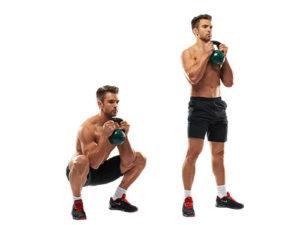
- For this type of squat all you need is a kettlebell. Hold the kettlebell up to your chest and sink down completing a basic squat.
Bulgarian Split Squat
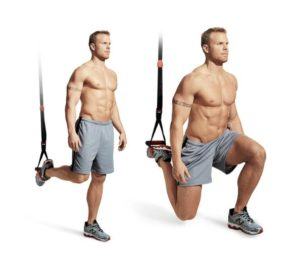
- This requires more balance and stability because as oppose to the normal squat, your rear leg is now elevated. Because of the elevation your lower back and front leg remains powerless leaving all the work to your hips.
- Move your self up and down completing your squat movements using your hips’ power and muscles.
Pistol Squat
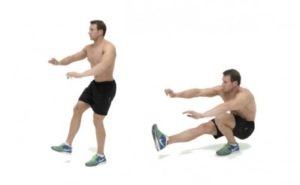
- Another squat that requires intense balancing skills. Awhile ago, your rear leg was the one who was elevated. Now let your front leg do the elevation.
- As you execute the squat position, extend one leg forward, keeping it straight and steady. To add support to your balance, extend arms forward as well paralleling them to the ground.
- For starters, utilize a bench to assist you. But as you progress, experiment with some weights and move on to a flat surface.
Now, it is time to put your A-game on, because you are about to find out the greater advantages of Barbell Hack Squat and Lunges in the world of squats and glute, inner thighs, legs and hamstring strengthening. It is, without a doubt, that in order to gain more, you have to do more. So, what perfect way to amplify your squats than to add barbells and lunges to your repertoire.
Barbell Hack Squat
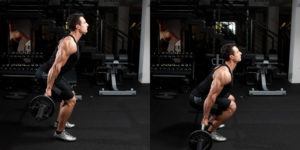
Many strength coaches consider this as the “King” of all squats. It may be the most underused exercise among others, but it is the most muscle-challenging of all. Among all other variations of squatting, the Barbell Hack Squat is the ultimate benchmark to effectively measure one’s caliber. The only equipment you need for this workout is a barbell. This exercise will mainly target your quadriceps, then your forearms, glutes, hamstrings and calves.
How to do it:
- Stand straight with your feet hip-width apart and hold the barbell behind your back.
- Hold the barbell with your hands shoulder-width apart and with an overhand grip. This is your starting position.
- If you feel a slight discomfort around the area of your wrist, it is best to use wrist wraps for a better grip.
- Keep your back straight at all times. Maintain an eye-level view focusing on one focal point to keep head steady as well.
- Squat down until your upper thighs are positioned parallel to the floor and inhale as you do this.
- Breathe out and use your heels to push-up back to the starting position. Squeeze your thighs for more support and stability.
- Repeat to number of desired repetitions.
There are different variations of the Barbell Hack Squat. By changing your stance, you are shifting the focus to other parts of your body. Stand in a shoulder-width stance and feel the magic burning in your quadriceps, butt and inner thighs. Stand wider than a shoulder-width stance and you will triple the effect on your inner thighs. Stand narrower than shoulder-width stance and it will add emphasis to your quadriceps.
Doing such variations will not only help you look leaner or muscular but it has also other benefits, one of which is to improve your balance. If you suffer from leg imbalance, this is the exercise you need to add to your daily grind to correct that imbalance. Aside from this exercise being relatively easy to do, given that you perform this in different stances, it provides your body and muscles a greater scale to improve in terms of balance, leg strength and leg coordination.
Lunges
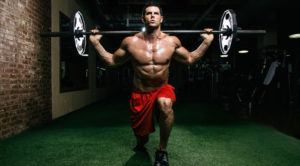
Lunges are the most basic and easiest way to improve strength in your quadriceps, glutes, core, calves and hamstrings. This exercise is the perfect epitome for the saying “simple but terrible”. Simple in a way of how simple the movements are, but despite the simplicity, it still manages to target a wide area from the total body muscles. Not to mention the benefits you get when performing this on a regular basis, for it could improve your leg strength, balance, flexibility, coordination and tone your muscles.
There are tons of variations for lunges. What will be included in this article is the standard lunge that you should be familiar of because this will be the foundation for any variation of lunges you will be encountering, and the Squat Lunges. In order to get the results, it is very vital to know how to execute correctly a basic lunge. Do not worry, afterwards, there is a list that includes some variations of lunges to which you can choose from to incorporate in your workout routine.
How to perfect your Lunge
- Maintain a straight upper body posture. Make sure that your back is not tensed but somehow relaxed and choose a specific focal point at eye-level to refrain your head from looking down or up.
- Step one foot forward and lower down your hips bending your knees to a 90 degree angle.
- The forwarded foot should maintain its knee directly in line with the ankle. The upper leg should be parallel to the ground.
- The rear foot should prevent its knee from touching the ground and should be supported by the toes.
- Using the weight from the heel of your forwarded leg push up back to the standing position.
Now, that you have learned the basic form of the Lunge it is time to apply it on different variations of lunges to also challenge different muscles. Listed below are some variations of lunges.
Dumbbell Lunge
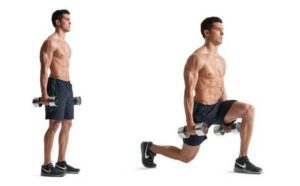
- Stand with your back straight while holding a dumbbell in each hand.
- Step two feet forward with your right leg and leave your left leg behind. This will be your starting position.
- Inhale as you lower your hips down into a lunge position while still maintaining a straight back. Ensure a 90 degree angle in both bent knees.
- Exhale and use the heel on your forwarded leg to push you back up to the starting position.
- Repeat to the number of desired repetitions.
- Switch the position of your legs and repeat the same movement.
Walking Lunge
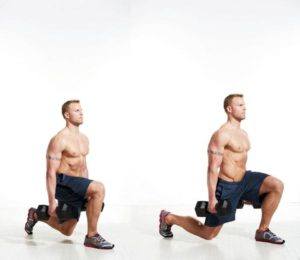
- Stand with your back straight while holding a dumbbell in each hand. This is your starting position.
- Step or slide with one foot two feet forward into a complete lunge position.
- Instead of going back to the standing position, shift your rear leg to the position of your forwarded leg to execute a moving forward action.
- Repeat to the desired number of repetitions.
Reverse Lunge
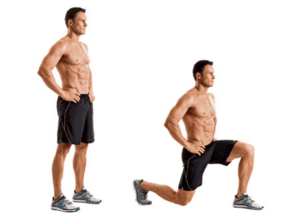
- Start with a hip-width standing position.
- The movement will be the same with the basic lunge, but now instead of stepping one foot forward we are going to reverse the movement.
- Step one foot backward at 2 feet apart. This is your starting position.
- Bend both knees as you lower your hips. Make sure that the knee of the rear leg should never touch the ground and should be supported by the toes. The forwarded leg should maintain the upper leg parallel to the ground.
- Using the weight from your rear leg, push yourself forward back to the starting position.
- Repeat to the desired number of repetitions.
Curtsy Lunge
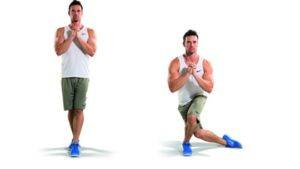
- Start with a standing position with feet shoulder-width apart. You can place your hands on your hips. This is your starting position.
- Take a wide step backward with your right foot crossing it behind your left leg, as if doing a curtsy. While doing the motion, slowly bend your left foot until its upper leg becomes parallel to the ground. Tighten your abs and keep a straight back at all times.
- As you cross one leg behind the other, you can either point or flex that foot and use its toes to support your land.
- Using the weight from your left leg, push back up to the starting position while still retracing the motion of the rear leg.
- Repeat to the desired number of repetitions.
Around-the-Clock Lunge
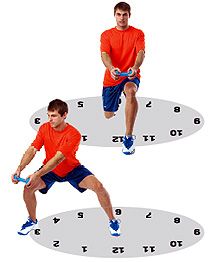
- Imagine that you are standing in a middle of a clock. The numbers 1-12 circles around you.
- Start with stepping your right foot forward to a lunge position at the number 12 of the imagined clock.
- Slightly step your right foot going to 1 all the way down to the number 6 while still maintaining the lunge position.
- Then, switch the position of your feet and finish off 7 to 12 with your left foot as the moving hand of the clock. You should always face at the number 12 the entire exercise.
- Once you have finished circling the clock, finish off with going back to the initial standing position.
Squat versus Lunge
It has always been an ongoing battle between these two. Both of them are considered the rulers to leg-shaping and butt-toning. They target the same muscles, such as the thighs, quadriceps, hamstrings and legs. But which is better, Squats or Lunges? Actually, both are important.
Squat is the foundation for any sitting or lifting exercise. It does not require much but it improves power and strength and still leads you to a healthy body. Lunge, on the other hand, is the foundation for any mobile exercise. Thus it requires more balance to execute perfectly the exercises. They are still interrelated because to achieve a well-executed lunge, you need to perfect your squat first.
Nevertheless, they are still important to improve one’s functionality, balance, strength and coordination in your day-to-day activities. In simple terms, incorporate both to your routine to further speed up your body development.
The Do’s and Don’ts

Before getting all excited in getting those muscles toned, you need to remember some certain precautions to ensure a safe workout session. It is always important to keep in mind some safety measures before, during and after working out as to do away with unexpected problems.
- In every workout do not ever forget to start with a simple head-to-toe warm-up just to prevent unwanted stress in certain areas of your body and as well as injuries.
- Reach your maximum potential but never over-exhaust yourself from the workout. Some always equate “dead tired” to “better results” which is actually the other way around. Draining yourself too much will actually give you more negative side effects than that of the positive ones.
- Hydrate yourself from time to time. Working out means sweating a lot, so, do not forget to refill your body’s water tank to prevent dehydration.
- Wear comfortable workout clothes and shoes. This is actually very important because aside from the tiring stress you will be getting from working out for hours you don’t want to add some of it just because your shoes were to tight or your shirt was too thick and hot.
- Eat or drink some protein 1 hour or 30 minutes, respectively, before you workout. It gives you enough energy to boost you up during your workout.
- Ensure proper execution of the exercises to prevent unwanted stress and injuries.
- TAKE A REST! It is okay to take some few minutes of rest between intervals off your workout. It is to recharge your body for the next burst of energy you will be doing.
You have now all the squat tricks you need to know to enjoy a perfect squat exercise. But also, don’t forget to have some fun during your workout sessions by experimenting with your body and potentials. You might be surprised of what your body can do.
